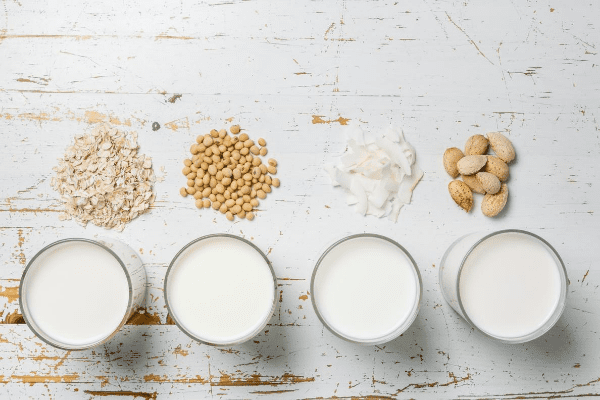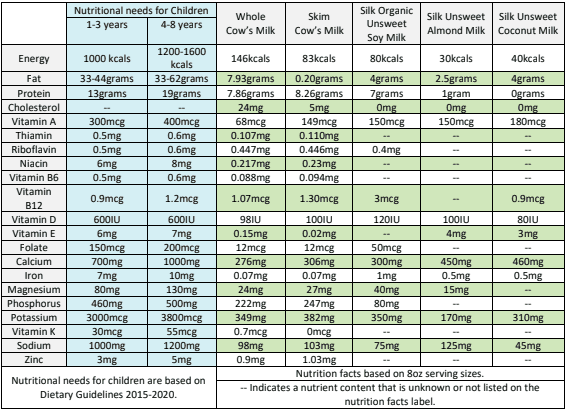 I have recently come across a few families who use non-dairy ‘milks’ instead of cow’s milk for their children. In the end, curiosity got the best of me. As a registered dietician, I decided to investigate the question: Are non-dairy ‘milks’ nutritionally adequate substitutes for children?
I have recently come across a few families who use non-dairy ‘milks’ instead of cow’s milk for their children. In the end, curiosity got the best of me. As a registered dietician, I decided to investigate the question: Are non-dairy ‘milks’ nutritionally adequate substitutes for children?
As a disclaimer – I am a registered dietitian and offer information based on reliable research. I do not represent the dairy industry nor any of the milk alternatives. But, in the name of full disclosure, my family is a MILK family! We LOVE milk! However, I put our preferences aside in order to seek out an unbiased answer to this important question. So, let’s take a step back and start at the beginning!
What are non-dairy ‘milks’?
Non-dairy ‘milks’ are emulsions (small particles suspended in a liquid) of a raw material that is filtered to ensure a smooth consistency. Most milk substitutes contain some sort of thickener to enhance its milk-like texture. Non-dairy ‘milks’ are separated into a few categories: cereal-based, legume-based, nut-based and pseudo-cereal based. Common non-dairy ‘milks’ include: oat, rice, corn, soy, coconut, cashew, almond, or quinoa.
They all have similar but varying health benefits. For example, soy ‘milks’ have been shown to reduced the risk of some cancers and cardiovascular disease. While almond milk research suggests it may have prebiotic powers in addition to its cholesterol-lowering potential. Oat milk contains high levels of a soluble fiber called beta-glucan which can help to slow gastric emptying thus improving blood sugars and overall digestive function.
Coconut milk is a common ingredient in South East Asian cuisine and gives foods a thick and rich texture due to its high fat content. Although, it is important to note that most coconut ‘milk’ drinks on the market only contain small amounts of actual coconut milk as they are diluted to provide a more typical cow’s milk experience. Thus the benefits that may be seen from consuming 100% coconut milk are likely reduced when choosing a coconut ‘milk’ drink.
As non-dairy ‘milks’ are inadequate in vitamins and minerals by themselves, they are fortified with additional nutrients. Some may also contain added sugars to improve overall taste profiles. It is common to find unsweetened, vanilla and other flavored versions of non-dairy ‘milks’.
How do non-dairy ‘milks’ compare to cow’s milk?
-
- Energy – The amount of calories in non-dairy ‘milks’ are generally about half of whole cow’s milk (which is the recommended milk for toddlers) but is comparable to the calories found in skim cow’s milk.
- Fats – Non-dairy ‘milks’ typically have less saturated fats; depending on what type of cow’s milk you are comparing it to. They also contain more monounsaturated fatty acids (MUFA) and polyunsaturated fatty acids (PUFA) which are known to be heart-healthy fats.
- Protein – Soy milk has the most protein of all the plant-based options at 8 grams but rice, almond and coconut milks contain negligible amounts.
- It is important to consider the bioavailability of proteins. Animal proteins are more readily absorbed than plant sources simply due to their molecular structure. When using a ‘bioavailability score’, cow’s milk has a score of 118%, soy milk scored decently at 100%, but rice milk scored only 37.1%. Not all manufacturers disclose their amino acid sources so it is impossible to assess the bioavailability of all non-dairy ‘milks’.
- Calcium – Because calcium is fortified into milk alternatives, most non-dairy ‘milks’ meet or exceed the calcium content of cow’s milk.
- However, researchers found that some fortified calcium has the tendency to settle to the bottom of soy milk containers. They noted that even when vigorously shaken there was a calcium toothpaste-like residue left on the bottom of cartons. Cartons that where not shaken contained only 30% of the calcium indicated on the label. And even when thoroughly shaken, cartons only contained 59% of calcium indicated on the label.
- Not all forms of fortified calcium are readily available in the human gut. Tricalcium Phosphate (a calcium used to fortify some soy milks) is only 24% bioavailable. Calcium carbonate is also used and is more readily available.
- Vitamin D – Whole cow’s milk and non-dairy ‘milks’ contain similar levels of vitamin D because both are added in after processing.
- Some researchers found an inverse relationship between preschoolers who consume non-dairy ‘milks’ and vitamin D serum levels. For each cup of non-dairy ‘milk’ consumed, their vitamin D levels decreased by 5%. The cause of this association is unclear but it seems to be an important question for bone health.
 Conclusions
Conclusions
To answer my initial question: Are non-dairy ‘milks’ nutritionally adequate substitutes for children? My professional answer is no, most non-dairy ‘milks’ are not nutritionally adequate without additional supplementation. I do think it is possible for a child to meet their nutritional needs while using a non-dairy ‘milk’ if it were absolutely necessary. For example, it would dangerous to offer a child with a milk allergy anything but a milk substitute. If this is the case, I would recommend using an unsweetened soy milk option. Look for one that is fortified with calcium carbonate. Soy milk is the only milk substitute that came even close on most of the key nutrients. But I would be cautious about making the switch without a medical directive to do so. The risks are far too great.
Here are some specific reasons for my answer:
-
- Non-dairy ‘milks’ may be great choices for some adults or even older teens. But the nutritional needs for a fully grown adult and a growing child are very different. The consequences of not meeting a child’s nutritional needs during such a critical time could be detrimental to them for the rest of their lives.
- Non-dairy ‘milks’ are not appropriate for infants (0-12 months) and can lead to protein/calorie malnutrition and vitamin/mineral deficiencies very quickly. These types of drinks are not meant to supply all nutritional needs. Formula or breast milk is still the recommended beverage for infants ages 6-12 months.
- Non-dairy ‘milk’ fat content is not high enough for children during specific periods. Children aged 12 to 24 months need higher amounts of fat in their diet to support brain development; which is why whole milk is the recommended milk for toddlers. While it is possible to get the additional fat from other food sources, toddlers are still learning self-feeding skills. Toddlers often struggle to get the food from their plate into their mouths and can easily tire of chewing. Because of this, they rely heavily on their liquids to fill gaps. If their milk isn’t stacking up, they will miss out.
- Protein content in all non-dairy ‘milks’ (expect for soy) are considerably lacking.
-
- Even children with lactose intolerance can consume a lactose free cow’s milk. Lactose free milk is just like regular cow’s milk but it has lactase (an enzyme) added to breakdown the lactose. This way children still get all the valuable protein, fat, and vitamins and minerals without the side effects of the lactose.
- Labels do not reflect bioavailability. As seen with protein, calcium and vitamin D studies, there is more to nutrients than simply what is contained in a liquid.
- Cow’s milk is rich in lots of other vitamins and minerals as well. Earlier I compared the nutrients found in non-dairy ‘milks’ to that of cow’s milk. I chose a few key nutrients to compare but cow’s milk has so many other nutrients that often aren’t mentioned.
I didn’t expect this article to be as pro-cow’s milk as it is. I truly wanted to create an honest comparison to investigate my initial question. I also didn’t realize the amount of passion I would feel while writing this article. But the idea of children not getting the nutrients they need pulls at my heart strings. I know cow’s milk isn’t perfect and it is hardly liquid gold but, in my professional opinion, it might as well be.
This information may not be applicable to everyone. For further questions, contact your primary provider for a referral to a dietitian who can offer individualized nutrition recommendations.
Credentials: Heather Plizga, MS, RD, LD
References:
- Verduci E, D’Elios S, Cerrato L, et al. Cow’s Milk Substitutes for Children: Nutritional Aspects of Milk from Different Mammalian Species, Special Formula and Plant-Based Beverages. Nutrients. 2019;11(8):1739.
- Singhal S, Baker RD, Baker SS. A Comparison of the Nutritional Value of Cow’s Milk and Nondairy Beverages. J Pediatr Gastroenterol Nutr. 2017;64(5):799-805.
- Swati Sethia, S. K. Tyagi, Rahul K. Anurag. Plant-based milk alternatives and emerging segment of functional beverages: A review. J Food Sci Technol. 2016;53(9):3408-3423.
- Sai Kranthi Vanga, Vijaya Raghavan. How well do plant based alternatives fare nutritionally compared with cow’s milk? J Food Sci Technol. 2018;55(1): 10-20.
- Heaney RP et al. Not all calcium-fortified beverages are created equal. Nutr Today. 2005; 40:39-44.
- Heaney RP et al. Bioavailability of the calcium in fortified soy imitation milk, with some observations on method. Am J Clin Nutr. 2000; 71:1166-69.
- Heaney RP, Rafferty K , Dowell MS, Bierman J. Calcium fortification systems differ in bioavailability. J Am Diet Assoc. 2005; 105: 807-09.
- Yongdong Zhao, Berdine R. Martin, Connie M. Weaver. Calcium bioavailability of calcium carbonate fortified soy milk equivalent to cow’s milk in young women. J Nutr. 2005; 135:2379 –2382.
- Grace J Lee, Catherine S. Birken, Patricia C Parkin, Gerald Lebovic, et al. Consumption of non-cow’s milk beverages and serum vitamin D levels in early childhood. CMAJ. 2014; 186(17): 1287-93.
- Hodges JK, Cao S. CLadis DP, Weaver CM. Lactose intolerance and bone health: The challenge of ensuring adequate calcium intake. Nutrients. 2019;11(4): 718.
- 2015-2020 Dietary Guidelines – Dietary Reference Intakes by Age/Sex
- Nutrient content of cow’s milk varieties
- Silk Organic Unsweet Soymilk nutrition facts
- Silk Unsweet Almondmilk nutrition facts
- Silk Unsweet Coconutmilk nutrition facts





